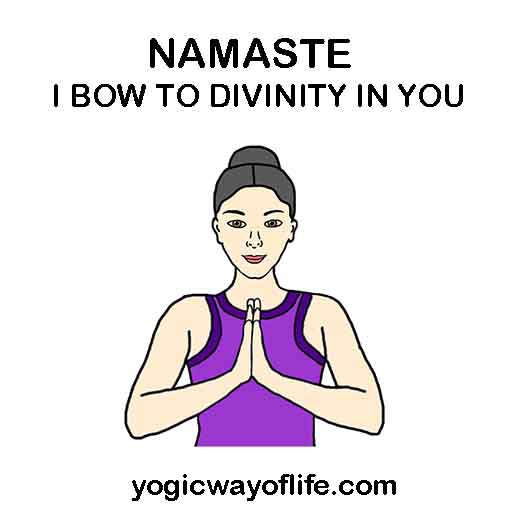Namaste or Namaskar is an Indian way of greetings or a gesture to acknowledge the divine in every soul. It means “I bow to you”.
Meaning of Namaste
In Sanskrit Namah means to bow and Te means you. ‘Namah’ and ‘Te’ combined becomes Namaste (Using sandhi rules of Sanskrit grammar) which means “I bow to you”. This tradition is popular in India, Nepal, Thailand, Sri Lanka and many other countries where the ancient Indian culture flourished over centuries.
How to say Namaste?
In the Hindu tradition, every individual is considered divine. Namaste or Namaskaram is a way of respecting the divine in the other person. The word Namaste (pronounced as Na–Ma–Sthay) is spoken with a slight bow with palms pressed together, fingers pointing upwards, in what is called Anjali Mudra or Namaskara Mudra or Pranamasana. The two palms are kept close to the center of the chest with the two thumbs touching the heart region, invoking the feeling of love and respect to the divine in the other person.
Usage of Namaste
Namaste can be used to express greetings, honor, gratitude and respect. Namaste is a common way of greeting towards guests, strangers, friends and relatives alike. In India, guests and even strangers coming to your house are treated as God. “Athithi Devo Bhava” or a “Guest is equal to God” is a common saying in India. Namaste can also be a gesture to acknowledge gratitude or a thank you gesture. This tradition is quite ancient and the proof can be seen in ancient temples sculptures and also from excavated articles as old as 3000 BC.
Variations of Namaste
Apart from the use of Namaste as a greeting, the gesture is also used in prayer and in practice of yoga asanas. Anjali Mudra or Pranamasana is used as a gesture for prayer in temple and worship. When you go to a Hindu temple, you pray in the Namaskar or Anjali mudra. The hands, touching the heart gives the feeling of acceptance and gratitude towards the divine energy radiating from the deity. This gesture can also be done with the hands raised to the forehead level or even above the head.
In yoga, there is a posture called Pranamasana which is same as the Namaskar mudra. It is the starting posture in the Sun salutation series of asanas or Surya Namaskara. Here it expresses the reverence to the Sun god, Surya.
Significance of Namaste for Modern World
In a world which is constantly fractured over different religious beliefs, Namaste can be a great unifier of people on this earth. It teaches us to respect the divine in others, irrespective of their religion, status or nationality.
Another aspect is regarding hygiene. Unlike a regular handshake, where two hands meet physically, Namaste is done without touching the body parts of the other person, maintaining a hygienic gesture.
The Namaste gesture also has to do with internalization of energy. Our vital energy or Prana constantly flows out through the extremities, esp. the hands. By joining the hands together, we create a circuit where the energy is circulated with the body, thus conserving pranic energy. The joined palms held close to the heart creates one-pointedness and mindfulness.
Saying Namaste with a gentle bow creates a sense of humility in the person and the other person feels valued and respected. In India, children at a young age are taught to say Namaste with palms joined together as part of the cultural training which creates an environment of love and peace in the society.
It is not surprising that more and more people across the globe are adopting Namaste as a simple, meaningful and beautiful form of greetings.
Let us all join palms and say Namaste!

